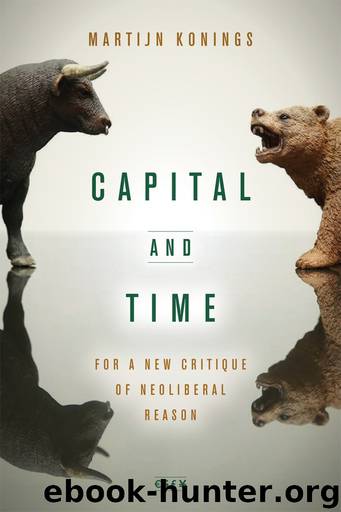Capital and Time by Konings Martijn

Author:Konings, Martijn [Konings, Martijn]
Language: eng
Format: epub
ISBN: 9781503603905
Publisher: Stanford University Press
Published: 2017-01-15T07:00:00+00:00
CHAPTER 9
Lineages of US Financial Governance
Although the Bagehot doctrine never provided a convincing theoretical solution to the problems associated with the lender-of-last-resort function, it nonetheless still had considerable relevance to the nineteenth-century context in Britain, where the large volume of trade-related debts provided a certain degree of stability for the banking system (Toniolo 2010: 63; Bignon et al. 2012). But the Bagehot doctrine never had much applicability in the context of the American system, which has always been inflected with a much stronger speculative dimension (Konings 2011) and never pivoted on trade-related bills (Hawtrey 1922: 226). Dynamics of leveraging and deleveraging were consequently a great deal more volatile, which meant that the need for a central bank was felt more urgently among bankers. But popular resistance, driven by sentiments that were not unlike Smith’s feelings about central banks, time and again prevented the emergence or creation of such an institution (Timberlake 1993).
By the early twentieth century, crises got progressively more severe and the effects of financial instability were felt increasingly widely. Under these circumstances the case for a central bank became more compelling, and the Federal Reserve System was created in 1913. But the highly speculative character of the American financial system meant that its central bank faced particular challenges. On the one hand, the moral hazard problems it created were particularly pronounced: the prospect of the availability of last-resort lending gave a boost to banks’ willingness to take risky financial positions (Degen 1987). On the other hand, it turned out that in the deleveraging movement the lender-of-last-resort function was not in fact all that effective: when financial dynamics are no longer governed even by a plausible notion of underlying value, intense doubt about the value of key securities sets in motion a fire-sale of bank assets that has no prospect of bottoming out and so continues to feed on itself (Calomiris and Mason 2003). In such situations, the provision of liquidity is entirely insufficient, as the crisis quickly appears to be one of solvency rather than mere liquidity. Simply put, during a crisis banks would have no sound collateral to offer (Wheelock 2010: 103), and lending on the principle of the Bagehot doctrine (even a considerably attenuated version of it) would therefore fail to arrest the deleveraging movement. These instabilities culminated in the crash of 1929 and the Depression, and the general crisis of capitalism.
The New Deal sought to create governance institutions that would improve the management of financial instability and actively work to prevent financial crises, but at the same time it needed to ensure the capacity of the system to respond to the growing popular demand for access to credit. The credit and securitization programs of the New Deal expanded the availability of government-assisted liquidity and made access dependent on investment in various forms of household debt (Hyman 2011). The government-sponsored enterprises essentially functioned as permanently available sources of liquidity, allowing banks to pass on their liquidity risk to a publicly supported institution. In addition, from the
Download
This site does not store any files on its server. We only index and link to content provided by other sites. Please contact the content providers to delete copyright contents if any and email us, we'll remove relevant links or contents immediately.
The Secret History by Donna Tartt(16622)
The Social Justice Warrior Handbook by Lisa De Pasquale(11489)
Thirteen Reasons Why by Jay Asher(7788)
This Is How You Lose Her by Junot Diaz(5771)
Weapons of Math Destruction by Cathy O'Neil(5036)
Zero to One by Peter Thiel(4824)
The Myth of the Strong Leader by Archie Brown(4789)
Promise Me, Dad by Joe Biden(4447)
Beartown by Fredrik Backman(4415)
Stone's Rules by Roger Stone(4415)
How Democracies Die by Steven Levitsky & Daniel Ziblatt(4398)
The Fire Next Time by James Baldwin(4342)
100 Deadly Skills by Clint Emerson(4076)
A Higher Loyalty: Truth, Lies, and Leadership by James Comey(4032)
Rise and Kill First by Ronen Bergman(4012)
The David Icke Guide to the Global Conspiracy (and how to end it) by David Icke(3881)
The Farm by Tom Rob Smith(3872)
Secrecy World by Jake Bernstein(3782)
The Doomsday Machine by Daniel Ellsberg(3730)
